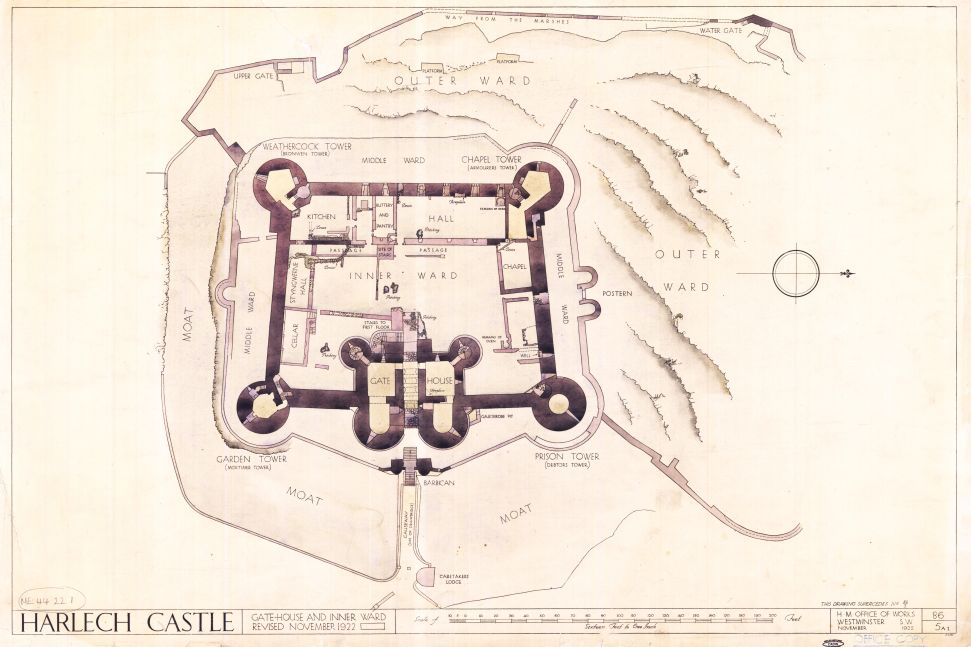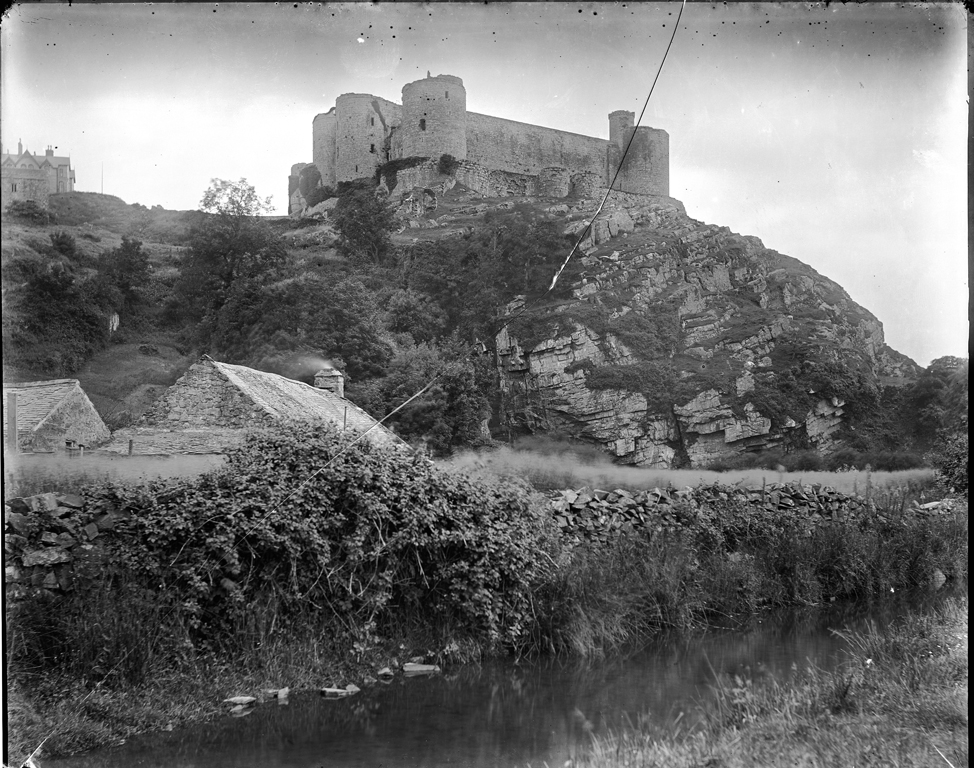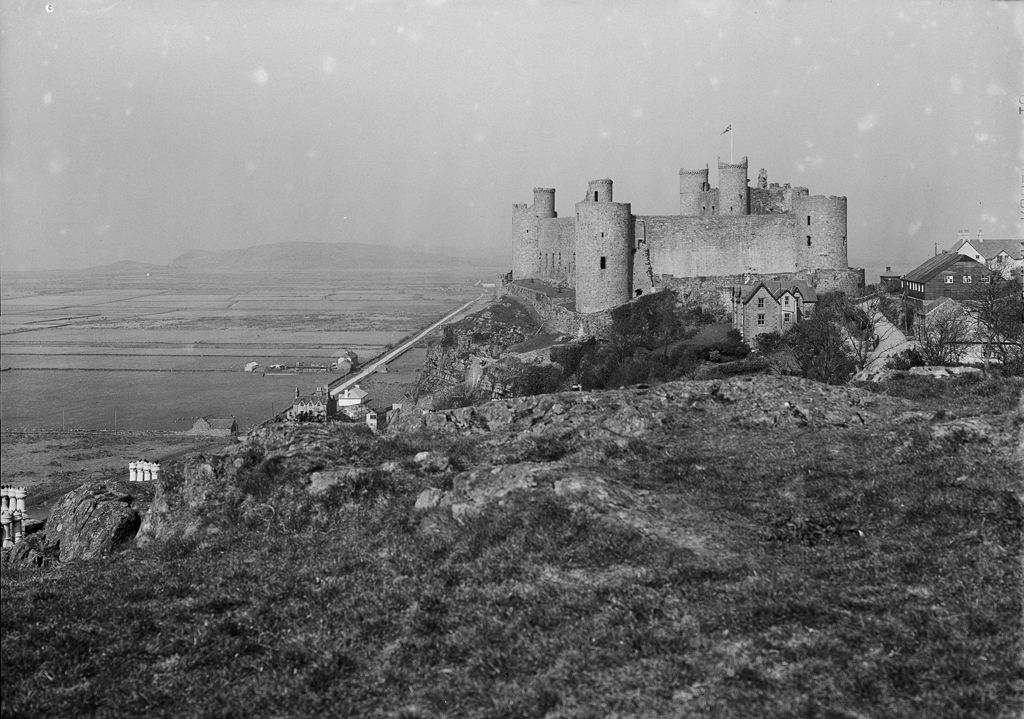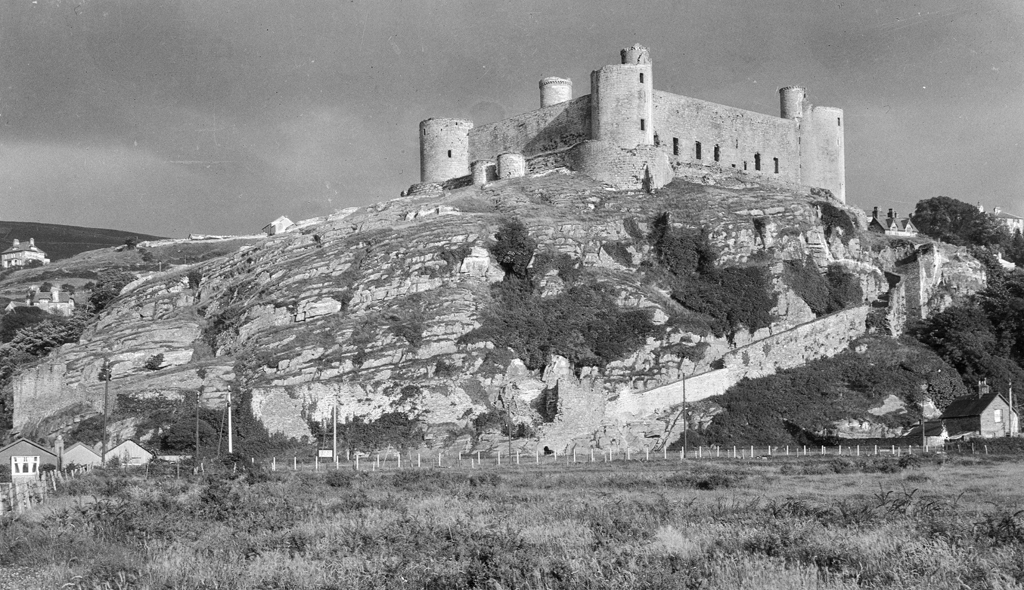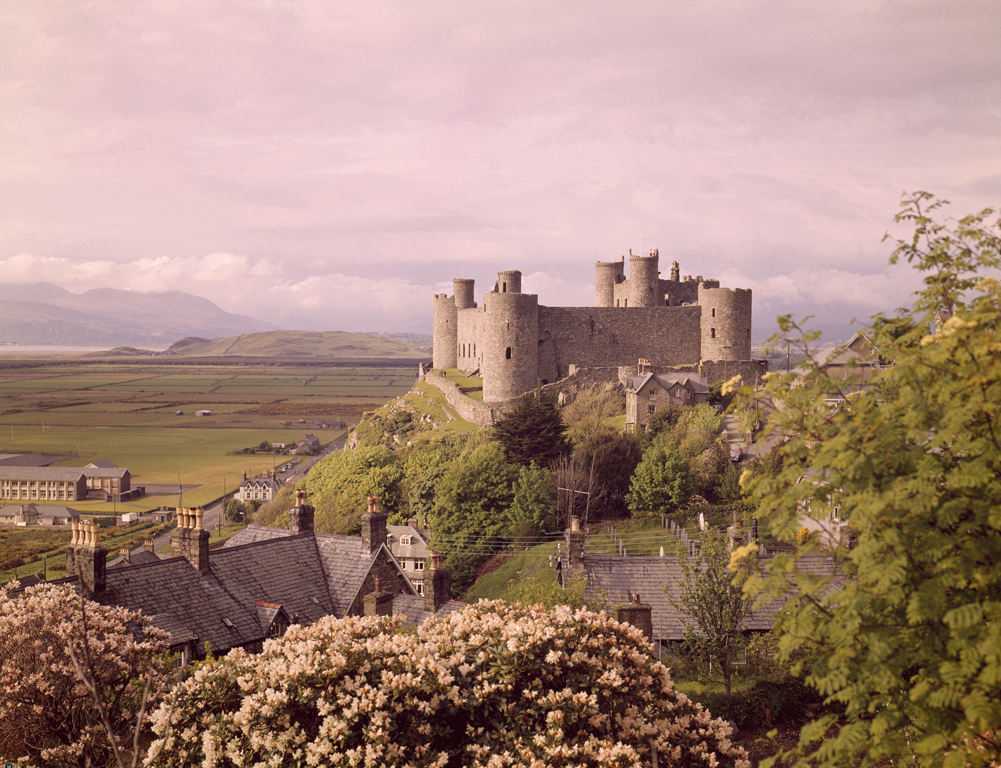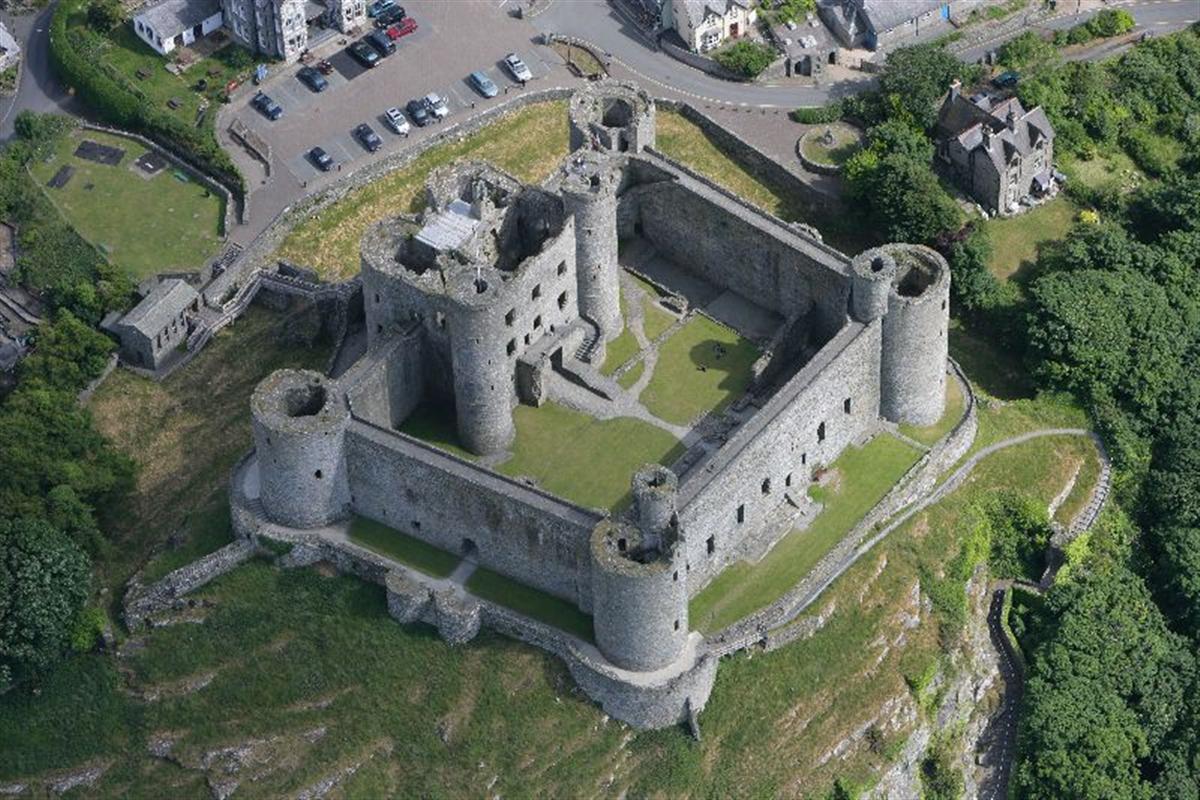Harlech Castle - Overview
Harlech Castle perches on top of a high cliff, affording one of the best views across the northern half of Cardigan Bay and large sections of Snowdonia on the landward side. According to Welsh mythology, the ruins of the present castle were built on top of a fortress that once belonged to the giant Bendigeidfran (the blessed Brân), who lived here with his sister Branwen, after whom one of the towers is named. However, archaeologists have found no evidence for a Welsh fortified structure predating Edward I’s castle.
Edward I commissioned the construction in 1283 as part of his great ‘Iron Ring’ of castles along the Welsh coast to subject the indigenous population to his rule. At that time, it was still possible to supply Harlech by boat as the sea reached all the way up to the cliffs. When Owain Glyndŵr laid the castle under siege in 1404, the garrison stationed there was grossly understaffed and surrendered themselves. As a result, Glyndŵr established his home seat and military headquarters here for the next four years. The most famous siege, however, occurred during the Wars of the Roses from 1461 to 1468. This siege, the longest in British history, is said to have inspired the song ‘Men of Harlech’.
Ever since the Romantic period, many tourists have been drawn to this remote part of Wales thanks to the combination of Harlech Castle’s picturesque situation and its exciting history. The German journalist Francis Brömel further delighted in the local tales of ghosts and will-o’-the-wisps hovering all over the marshland that had appeared by the natural build-up of silt over the centuries.
Accounts of Travel
"Sommerbilder aus England und Wales", 1874
Friedrich Althaus (1829 – 1897)
In Harlech bilden den Hauptanziehungspunkt die imposanten Reste einer von Eduard I. gegründeten alten Burg. Der Eroberer von Wales baute diese Burg von Harlech zugleich mit den Burgen von Carnarvon und Beaumaris, um die widerspänstigen Walliser im Zaume zu halten, und bis gegen das Ende des 15. Jahrhunderts spielte sie als Sammelpunkt in Aufständen, als Zufluchtsort von Verbannten, durch Belagerungen und Eroberungen eine hervorragende Rolle in der Geschichte von Wales. Zuletzt leistete sie unter dem wälschen Häuptling Dafydd a[p] Einion dem sie belagernden Eduard IV. so tapferen Widerstand, daß dieser den Verteidigern einen freien Abzug gewähren mußte, zu Ehren welches Ereignisses ein wälscher Barde eine Art walliser Marseillaise dichtete, die noch jetzt als „The march of the men of Harlech“ im Volksmunde fortlebt. Wir bestiegen die Burg von Harlech an einem jener bewölkten Vormittage, wo die Wage des Wetters ungewiß zwischen Regen und Sonnenschein schwankte. Die Burg ist nicht so umfangreich, wie die Burgen von Beaumaris und Carnarvon, aber ihre herrliche Lage auf einem schroff über die umgebende Uferebene aufsteigenden Felsenberge und die wundervolle Aussicht von der Höhe ihrer altersbraunen, epheuumgrünten Mauern über das Meer und die schön geschwungenen Küstenlinien von Cardigan-Bay und tief hinein in das Bergland von Nordwales, bringt einen imposanten Eindruck hervor.
The imposing ruins of an old castle established by Edward I are the main attraction of Harlech. The conqueror of Wales built this castle at the same time as those of Caernarfon and Beaumaris in order to rein in the obstinate Welsh. And with its sieges and captures, it played an important role in the history of Wales as rallying point during insurrections and as a sanctuary for the banished until the fifteenth century. One last time, under the Welsh chieftain Dafydd ap Einion, it withstood the besieging Edward IV so bravely that in honour of this event a Welsh bard composed a sort of Welsh Marseillaise which still continues on in the vernacular as ‘The March of the Men of Harlech’. We climbed up this castle of Harlech on one of these overcast mornings, when the weather scales sway indecisively between rain and sunshine. The castle is not as extensive as those of Beaumaris and Caernarfon, but its magnificent situation on a ragged, rocky crag looming over the surrounding coastal plain, and the wonderful prospect from its aged, ivy-clad walls over the see and the beautifully arching coast line of Cardigan Bay and far into the mountain uplands of north Wales give an imposing impression.
Nordland-Fahrten. Zweite Abteilung, c. 1870s
Franz Brömel (1829 – 1904)
Auf einer solchen Bahn, „wo Niemand Eile hat“, erreichen wir Schloß Harlech, auf hoher Klippe über weitem Marschland gelegen; gleichsam einer Theaterloge, zu dem Zwecke erbaut, um den Gigantenberg von Wales, den Snowdon, von seiner imponirendsten Seite betrachten zu können. Dieses Marschland ist eine Fundgrube von Geistergeschichten. Es scheint bei Nacht mitunter in Flammen zu stehen, indem seine Ausdünstung Milliarden von Irrlichtern erzeugt. Diese Ursache zu entdecken, brauchte es ein volles Jahrtausend, denn bis zu Anfang dieses Jahrtausends konnten Erscheinungen, die schon in Gedichten aus dem neunten Jahrhundert erwähnt werden, nichts Anderes als „eine nächtliche Heerschau leuchtender Seelen auf uraltem Schlachtfelde“ bedeuten. Über das Alter des Schlosses weiß man nur, daß im letzten Jahrhundert eine Reparatur desselben nöthig wurde, als es bereits dreihundert Jahre alt gewesen. Nach einer alten Schlachtschilderung wurden in seinen Hallen von einem Eroberer 6000 Mann niedergemetzelt, was auf beträchtlichen Umfang schließen läßt, den auch die heute noch vorhandenen Ruinen bewahrheiten. In der Zeit von 1404 bis 1647 wurde das Schloß, damals noch von der See erreicht, fünf Mal belagert und erobert; es war im vorigen Jahrhundert wohl erhalten genug, um einen König und seinen Hofstaat zu beherrbergen und ist noch heute Eigenthum der Krone. Als Curiosum sei aus einer überaus reichen Chronik gemeldet, daß schon im Jahre 1805, also lange zuvor, ehe die Zeitungen das Ding entdeckten, an dieser Küste von Cardigan die berühmte „Seeschlange“ zum ersten Male gesehen wurde!
On such a railway line, ‘where no one is in any hurry’, we reached Harlech Castle, located on high on a rock above a wide marshland. This rock resembles a theatre box built for the purpose of viewing the giant’s mount of Wales, Snowdon, from its most imposing side. This marshland is a treasure-chest for ghost stories. Now and then at night, it is as if it is ablaze as its vapours produce billions of will-o’-the-wisps. The discovery of their origin took a whole millennium, because until the beginning of this century, apparitions that had already been noted in poems in the ninth century could not signify anything else but ‘a nocturnal parade of luminous souls on ancient battlefield’. Regarding the age of the castle, it is only known that during the last century, when it was already three hundred years old, repairs had become necessary. According to an old description of battle, one conqueror massacred six thousand men in its halls, which is indicative of the castle’s considerable dimensions, proven true by the still existing ruins today. Between the years 1404 and 1647, the castle, which was still accessible from the sea, was under siege and conquered five times. In the previous century, it was still preserved well enough to provide lodgings for a king and his court and is still owned by the Crown. One more curiosity reported in an exceedingly abundant chronicle shall be mentioned: already in the year 1805, long before the newspapers got wind of it, the famous ‘sea serpent’ was spotted on the coast of Cardigan for the first time.
